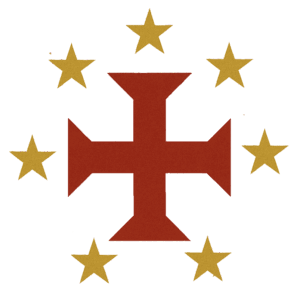The Hidden Power of Pilgrim Symbols
Since medieval times, pilgrims have worn or carried symbols to keep them safe. These were never just decorations. They were shields for the soul.
The Jerusalem Cross – Five crosses in one, said to represent Christ’s wounds or the spread of the Gospel. Still etched into stone and silver in the Holy Land today.

The Scallop Shell – Carried by pilgrims to Santiago. Its lines all lead to one point, reminding the traveler that many paths lead to the same truth.

The Tau Cross – Worn by Franciscan-inspired walkers. A mark of humility, hope, and the road less traveled.


✨ The Forgotten Templar Symbol from Tomar
According to legend, a Portuguese Templar knight named Dom Afonso de Tavira rode to Jerusalem in 1127. There, he was given a small iron keyring etched with a cross encircled by stars—a symbol said to protect him through battles, ambushes, and sickness. Wherever he went, danger seemed to step aside.
That mark—the Cross of Stars—was whispered among pilgrims as a talisman of safety and guidance. Though the keyring itself was buried long ago, the symbol lived on in stories.
Today, it’s being revived in the very place where Afonso first took his vow: Tomar, the ancient heart of the Knights Templar in Portugal.
🛡️ A Modern Pilgrim’s Token: The Cross of Stars
If you’re coming to Tomar—a spiritual powerhouse of medieval energy—you don’t leave empty-handed. Pilgrims today are picking up Cross of Stars pendants, keyrings, and badges as a quiet nod to those who walked before them. Not as superstition. As solidarity.
As a way of saying:
I walk under the same sky. I carry the same hope.
So if you’re planning your journey—whether to the Holy Land, to Fátima, or just through a personal season of searching—stop by Tomar. Pick up the symbol. Carry the legend. Walk protected.